Development of a Glucose Sensor Based on Glucose Dehydrogenase Using Polydopamine-Functionalized Nanotubes
Abstract
1. Introduction
2. Materials and Methods
2.1. Chemicals and Reagents
2.2. Fabrication of Ru(dmo-bpy)2Cl2/GDH/PDA-MWCNT/SPCEs
2.2.1. Synthesis of PDA-MWCNT
2.2.2. Fabrication of Ru(dmo–bpy)2Cl2/GDH/PDA-MWCNT/SPCE
2.3. Electrochemical Measurements
3. Results and Discussions
3.1. Physicochemical Characterization of PDA-MWCNT
3.2. Electrochecmial Characterization of Ru(dmo–bpy)2Cl2/GDH/PDA-MWCNT/SPCEs
3.3. Glucose Measurement on Ru(dmo-bpy)2Cl2/GDH/PDA-MWCNT/SPCEs
3.4. Interference Species Testing and Glucose Measurement in Serum
4. Conclusions
Supplementary Materials
Author Contributions
Funding
Institutional Review Board Statement
Informed Consent Statement
Data Availability Statement
Acknowledgments
Conflicts of Interest
References
- Zhuge, J.; Zhang, W. Principles of molecular biology. In Molecular Diagnostics in Dermatology and Dermatopathology; Springer: Berlin/Heidelberg, Germany, 2011; pp. 13–25. [Google Scholar]
- Sehit, E.; Altintas, Z. Significance of nanomaterials in electrochemical glucose sensors: An updated review (2016–2020). Biosens. Bioelectron. 2020, 159, 112165. [Google Scholar] [CrossRef] [PubMed]
- Kerner, W.; Brückel, J. Definition, classification and diagnosis of diabetes mellitus. Exp. Clin. Endocrinol. Diabetes 2014, 122, 384–386. [Google Scholar] [CrossRef] [PubMed]
- Ognjanović, M.; Stanković, V.; Knežević, S.; Antić, B.; Vranješ-Djurić, S.; Stanković, D.M. TiO2/APTES cross-linked to carboxylic graphene based impedimetric glucose biosensor. Microchem. J. 2020, 158, 105150. [Google Scholar] [CrossRef]
- Liu, Y.; Nan, X.; Shi, W.; Liu, X.; He, Z.; Sun, Y.; Ge, D. A glucose biosensor based on the immobilization of glucose oxidase and Au nanocomposites with polynorepinephrine. RSC Adv. 2019, 9, 16439–16446. [Google Scholar] [CrossRef]
- Suzuki, N.; Lee, J.; Loew, N.; Takahashi-Inose, Y.; Okuda-Shimazaki, J.; Kojima, K.; Mori, K.; Tsugawa, W.; Sode, K. Engineered glucose oxidase capable of quasi-direct electron transfer after a quick-and-easy modification with a mediator. Int. J. Mol. Sci. 2020, 21, 1137. [Google Scholar] [CrossRef]
- Al-Sagur, H.; Komathi, S.; Khan, M.; Gurek, A.; Hassan, A. A novel glucose sensor using lutetium phthalocyanine as redox mediator in reduced graphene oxide conducting polymer multifunctional hydrogel. Biosens. Bioelectron. 2017, 92, 638–645. [Google Scholar] [CrossRef]
- Deng, H.; Shen, W.; Gao, Z. An interference-free glucose biosensor based on an anionic redox polymer-mediated enzymatic oxidation of glucose. ChemPhysChem 2013, 14, 2343–2347. [Google Scholar] [CrossRef]
- Ivanova, E.V.; Sergeeva, V.S.; Oni, J.; Kurzawa, C.; Ryabov, A.D.; Schuhmann, W. Evaluation of redox mediators for amperometric biosensors: Ru-complex modified carbon-paste/enzyme electrodes. Bioelectrochemistry 2003, 60, 65–71. [Google Scholar] [CrossRef]
- Vashist, S.K.; Zheng, D.; Al-Rubeaan, K.; Luong, J.H.; Sheu, F.-S. Technology behind commercial devices for blood glucose monitoring in diabetes management: A review. Anal. Chim. Acta 2011, 703, 124–136. [Google Scholar] [CrossRef]
- Kornecki, J.F.; Carballares, D.; Tardioli, P.W.; Rodrigues, R.C.; Berenguer-Murcia, Á.; Alcantara, A.R.; Fernandez-Lafuente, R. Enzyme production ofd-gluconic acid and glucose oxidase: Successful tales of cascade reactions. Catal. Sci. Technol. 2020, 10, 5740–5771. [Google Scholar] [CrossRef]
- Deng, H.; Teo, A.K.L.; Gao, Z. An interference-free glucose biosensor based on a novel low potential redox polymer mediator. Sens. Actuators B Chem. 2014, 191, 522–528. [Google Scholar] [CrossRef]
- Cass, A.E.; Davis, G.; Francis, G.D.; Hill, H.A.O.; Aston, W.J.; Higgins, I.J.; Plotkin, E.V.; Scott, L.D.; Turner, A.P. Ferrocene-mediated enzyme electrode for amperometric determination of glucose. Anal. Chem. 1984, 56, 667–671. [Google Scholar] [CrossRef] [PubMed]
- Raba, J.; Mottola, H.A. Glucose oxidase as an analytical reagent. Crit. Rev. Anal. Chem. 1995, 25, 1–42. [Google Scholar] [CrossRef]
- Blanford, C.F. The birth of protein electrochemistry. Chem. Commun. 2013, 49, 11130–11132. [Google Scholar] [CrossRef]
- Lee, I.; Loew, N.; Tsugawa, W.; Lin, C.-E.; Probst, D.; La Belle, J.T.; Sode, K. The electrochemical behavior of a FAD dependent glucose dehydrogenase with direct electron transfer subunit by immobilization on self-assembled monolayers. Bioelectrochemistry 2018, 121, 1–6. [Google Scholar] [CrossRef]
- Haque, A.M.J.; Nandhakumar, P.; Yang, H. Specific and rapid glucose detection using NAD-dependent glucose dehydrogenase, diaphorase, and osmium complex. Electroanalysis 2019, 31, 876–882. [Google Scholar] [CrossRef]
- Jeon, W.-Y.; Lee, J.-H.; Dashnyam, K.; Choi, Y.-B.; Kim, T.-H.; Lee, H.-H.; Kim, H.-W.; Kim, H.-H. Performance of a glucose-reactive enzyme-based biofuel cell system for biomedical applications. Sci. Rep. 2019, 9, 1–9. [Google Scholar] [CrossRef]
- Lisdat, F. PQQ-GDH–Structure, function and application in bioelectrochemistry. Bioelectrochemistry 2020, 134, 107496. [Google Scholar] [CrossRef]
- Stolarczyk, K.; Rogalski, J.; Bilewicz, R. NAD (P)-dependent glucose dehydrogenase: Applications for biosensors, bioelectrodes, and biofuel cells. Bioelectrochemistry 2020, 135, 107574. [Google Scholar] [CrossRef]
- Tsuruoka, N.; Sadakane, T.; Hayashi, R.; Tsujimura, S. Bimolecular rate constants for FAD-dependent glucose dehydrogenase from aspergillus terreus and organic electron acceptors. Int. J. Mol. Sci. 2017, 18, 604. [Google Scholar] [CrossRef]
- Lee, H.; Lee, Y.S.; Reginald, S.S.; Baek, S.; Lee, E.M.; Choi, I.-G.; Chang, I.S. Biosensing and electrochemical properties of flavin adenine dinucleotide (FAD)-Dependent glucose dehydrogenase (GDH) fused to a gold binding peptide. Biosens. Bioelectron. 2020, 165, 112427. [Google Scholar] [CrossRef]
- Loew, N.; Tsugawa, W.; Nagae, D.; Kojima, K.; Sode, K. Mediator preference of two different FAD-dependent glucose dehydrogenases employed in disposable enzyme glucose sensors. Sensors 2017, 17, 2636. [Google Scholar] [CrossRef] [PubMed]
- Jeon, W.-Y.; Choi, Y.-B.; Lee, B.-H.; Jo, H.-J.; Jeon, S.-Y.; Lee, C.-J.; Kim, H.-H. Glucose detection via Ru-mediated catalytic reaction of glucose dehydrogenase. Adv. Mater. Lett. 2018, 9, 220–224. [Google Scholar] [CrossRef]
- Choi, Y.-B.; Kim, H.-S.; Jeon, W.-Y.; Lee, B.-H.; Shin, U.S.; Kim, H.-H. The electrochemical glucose sensing based on the chitosan-carbon nanotube hybrid. Biochem. Eng. J. 2019, 144, 227–234. [Google Scholar] [CrossRef]
- Bollella, P.; Katz, E. Enzyme-based biosensors: Tackling electron transfer issues. Sensors 2020, 20, 3517. [Google Scholar] [CrossRef] [PubMed]
- Pinyou, P.; Blay, V.; Muresan, L.M.; Noguer, T. Enzyme-modified electrodes for biosensors and biofuel cells. Mater. Horiz. 2019, 6, 1336–1358. [Google Scholar] [CrossRef]
- Lee, H.; Dellatore, S.M.; Miller, W.M.; Messersmith, P.B. Mussel-inspired surface chemistry for multifunctional coatings. Science 2007, 318, 426–430. [Google Scholar] [CrossRef] [PubMed]
- Zhao, P.; Chen, C.; Ni, M.; Peng, L.; Li, C.; Xie, Y.; Fei, J. Electrochemical dopamine sensor based on the use of a thermosensitive polymer and an nanocomposite prepared from multiwalled carbon nanotubes and graphene oxide. Microchim. Acta 2019, 186, 134. [Google Scholar] [CrossRef]
- Tursynbolat, S.; Bakytkarim, Y.; Huang, J.; Wang, L. Ultrasensitive electrochemical determination of metronidazole based on polydopamine/carboxylic multi-walled carbon nanotubes nanocomposites modified GCE. J. Pharm. Anal. 2018, 8, 124–130. [Google Scholar] [CrossRef]
- Kanyong, P.; Krampa, F.D.; Aniweh, Y.; Awandare, G.A. Polydopamine-functionalized graphene nanoplatelet smart conducting electrode for bio-sensing applications. Arab. J. Chem. 2020, 13, 1669–1677. [Google Scholar] [CrossRef]
- Martín, M.; Orive, A.G.; Lorenzo-Luis, P.; Creus, A.H.; González-Mora, J.L.; Salazar, P. Quinone-rich poly(dopamine) magnetic nanoparticles for biosensor applications. ChemPhysChem 2014, 15, 3742–3752. [Google Scholar] [CrossRef]
- Tan, Y.; Deng, W.; Li, Y.; Huang, Z.; Meng, Y.; Xie, Q.; Ma, M.; Yao, S. Polymeric bionanocomposite cast thin films with in situ laccase-catalyzed polymerization of dopamine for biosensing and biofuel cell applications. J. Phys. Chem. B 2010, 114, 5016–5024. [Google Scholar] [CrossRef]
- Ho, C.-C.; Ding, S.-J. The pH-controlled nanoparticles size of polydopamine for anti-cancer drug delivery. J. Mater. Sci. Mater. Med. 2013, 24, 2381–2390. [Google Scholar] [CrossRef]
- Dreyer, D.R.; Miller, D.J.; Freeman, B.D.; Paul, D.R.; Bielawski, C.W. Elucidating the structure of poly (dopamine). Langmuir 2012, 28, 6428–6435. [Google Scholar] [CrossRef]
- Hong, M.-S.; Park, Y.; Kim, T.; Kim, K.; Kim, J.-G. Polydopamine/carbon nanotube nanocomposite coating for corrosion resistance. J. Materiom. 2020, 6, 158–166. [Google Scholar] [CrossRef]
- Singh, R.K.; Devivaraprasad, R.; Kar, T.; Chakraborty, A.; Neergat, M. Electrochemical impedance spectroscopy of oxygen reduction reaction (ORR) in a rotating disk electrode configuration: Effect of ionomer content and carbon-support. J. Electrochem. Soc. 2015, 162, F489. [Google Scholar] [CrossRef]
- Navaee, A.; Salimi, A. FAD-based glucose dehydrogenase immobilized on thionine/AuNPs frameworks grafted on amino-CNTs: Development of high power glucose biofuel cell and biosensor. J. Electroanal. Chem. 2018, 815, 105–113. [Google Scholar] [CrossRef]
- Guzsvány, V.; Anojčić, J.; Vajdle, O.; Radulović, E.; Madarász, D.; Kónya, Z.; Kalcher, K. Amperometric determination of glucose in white grape and in tablets as ingredient by screen-printed electrode modified with glucose oxidase and composite of platinum and multiwalled carbon nanotubes. Food Anal. Methods 2019, 12, 570–580. [Google Scholar] [CrossRef]
- Gao, Q.; Guo, Y.; Liu, J.; Yuan, X.; Qi, H.; Zhang, C. A biosensor prepared by co-entrapment of a glucose oxidase and a carbon nanotube within an electrochemically deposited redox polymer multilayer. Bioelectrochemistry 2011, 81, 109–113. [Google Scholar] [CrossRef]
- Phetsang, S.; Jakmunee, J.; Mungkornasawakul, P.; Laocharoensuk, R.; Ounnunkad, K. Sensitive amperometric biosensors for detection of glucose and cholesterol using a platinum/reduced graphene oxide/poly (3-aminobenzoic acid) film-modified screen-printed carbon electrode. Bioelectrochemistry 2019, 127, 125–135. [Google Scholar] [CrossRef]
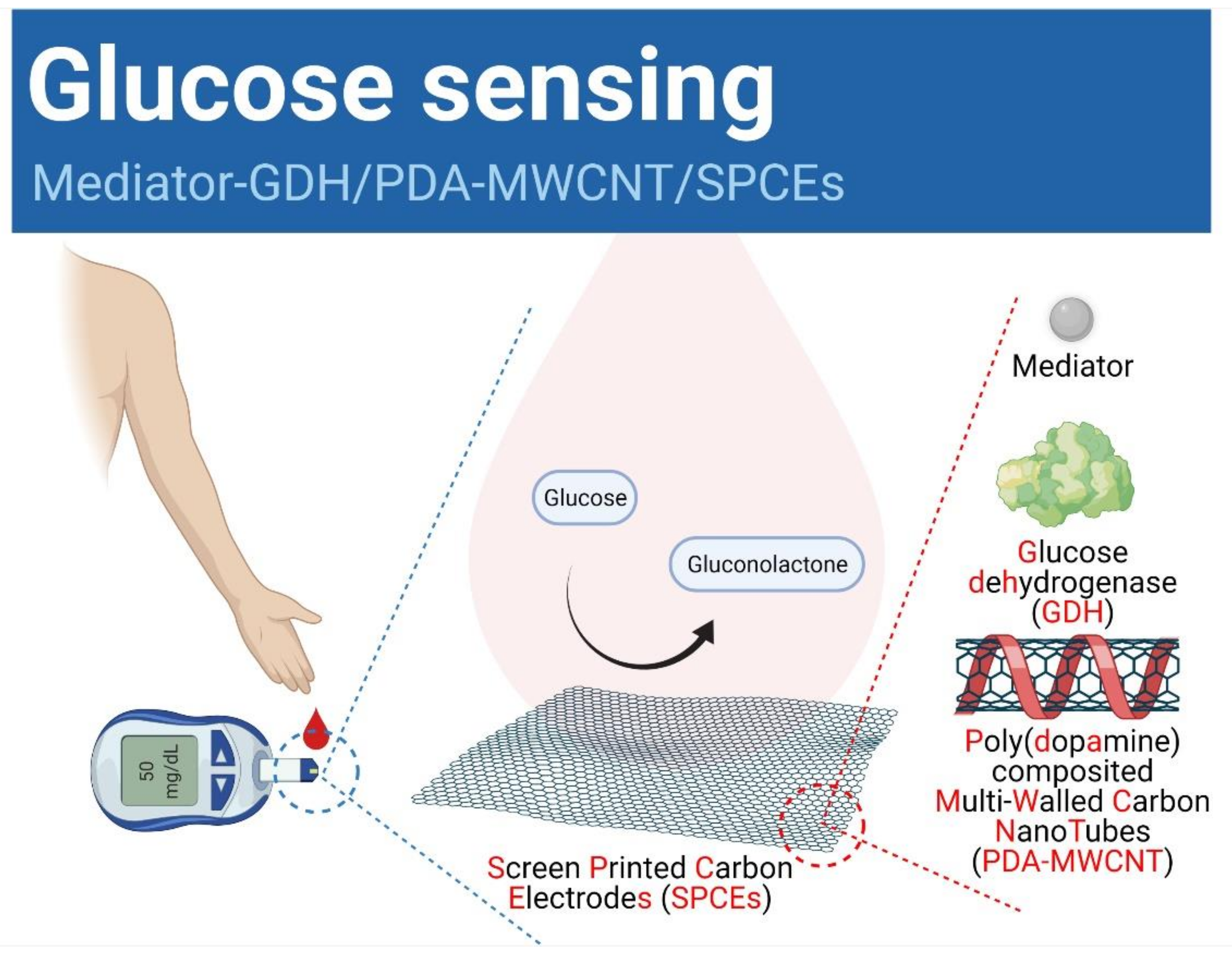

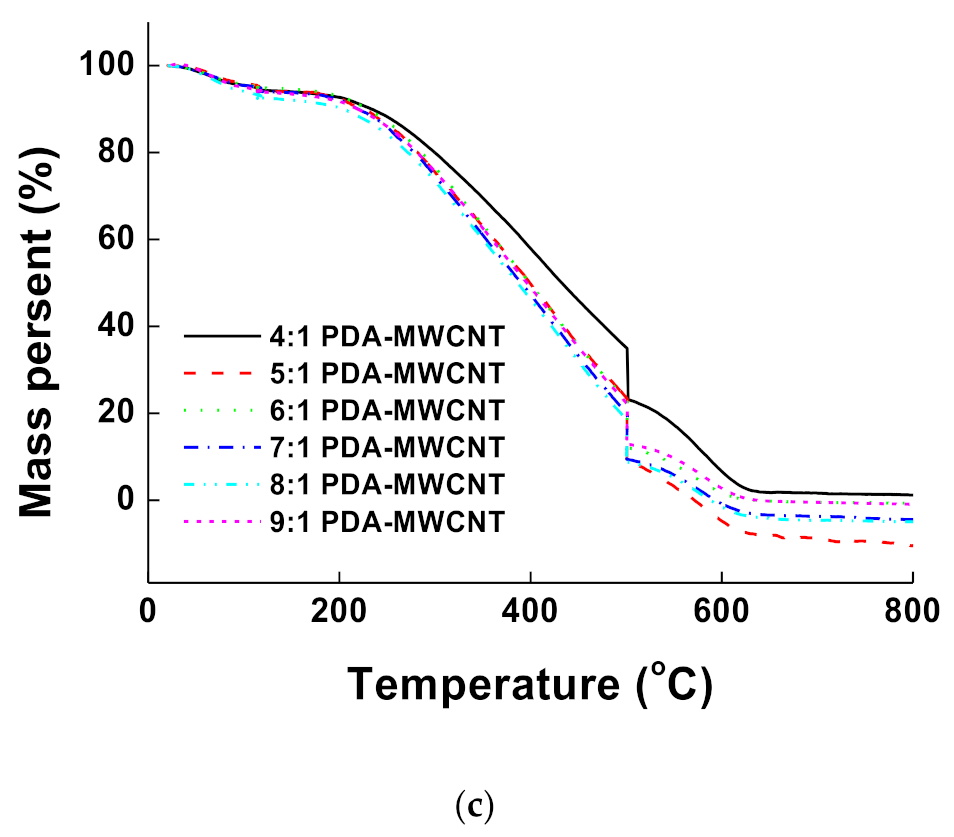
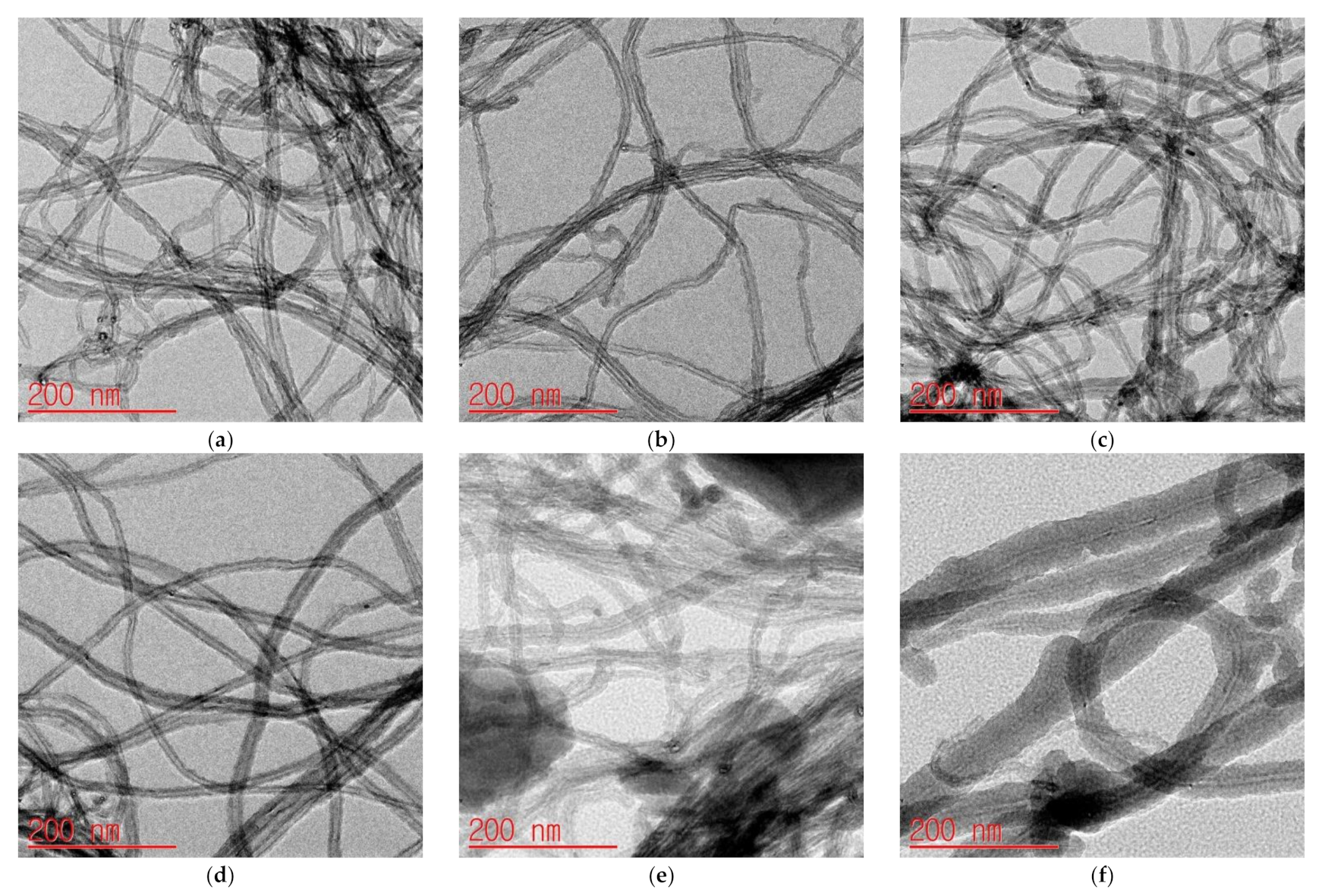
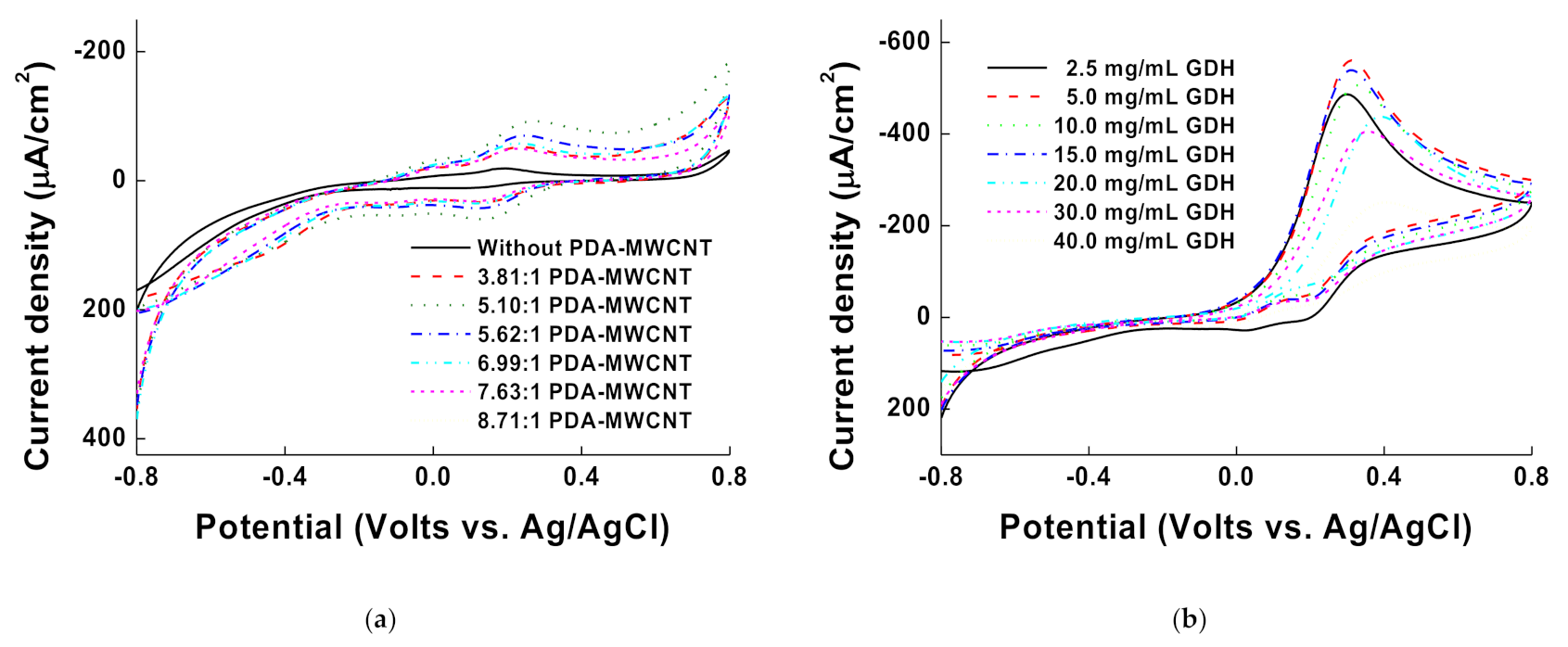
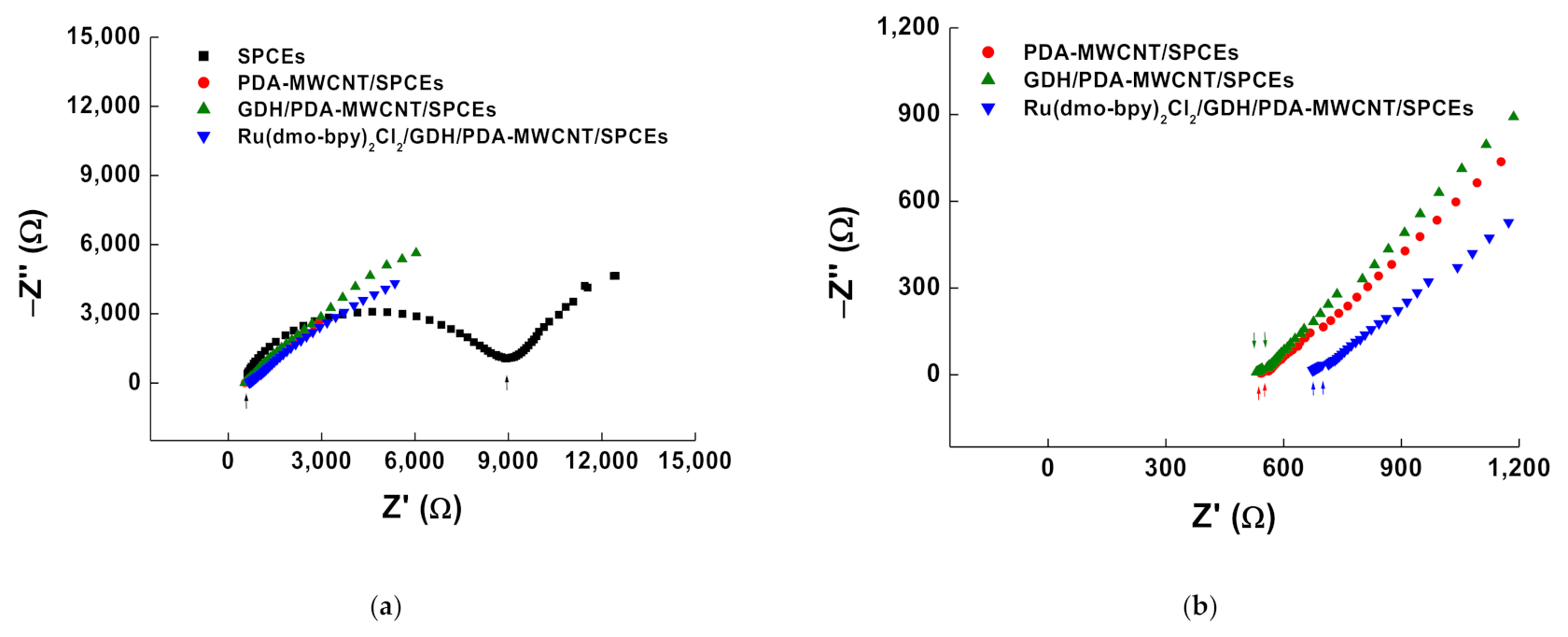
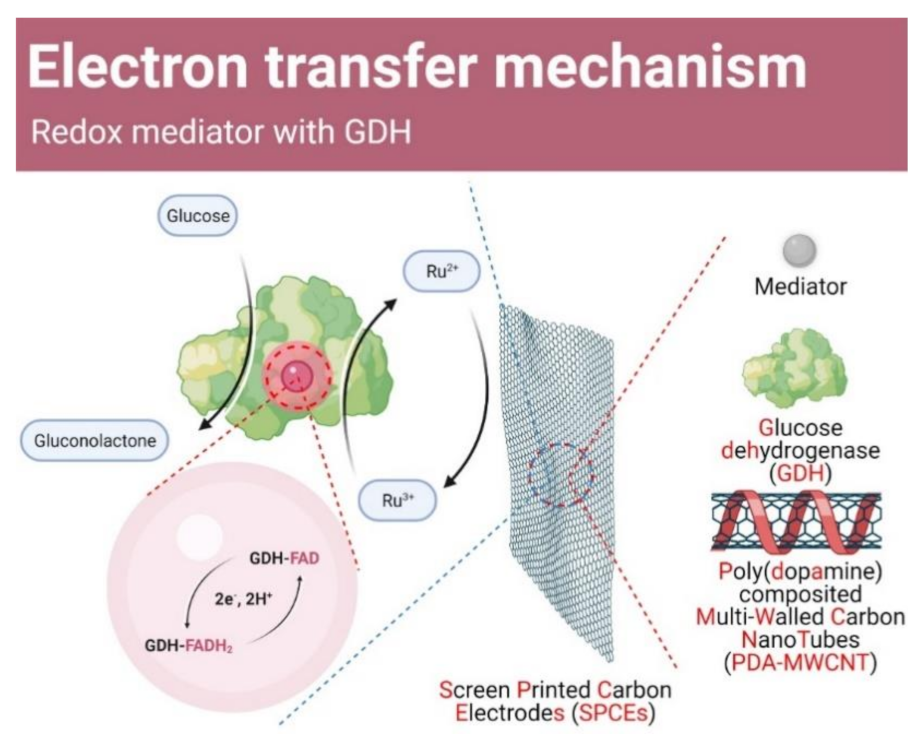
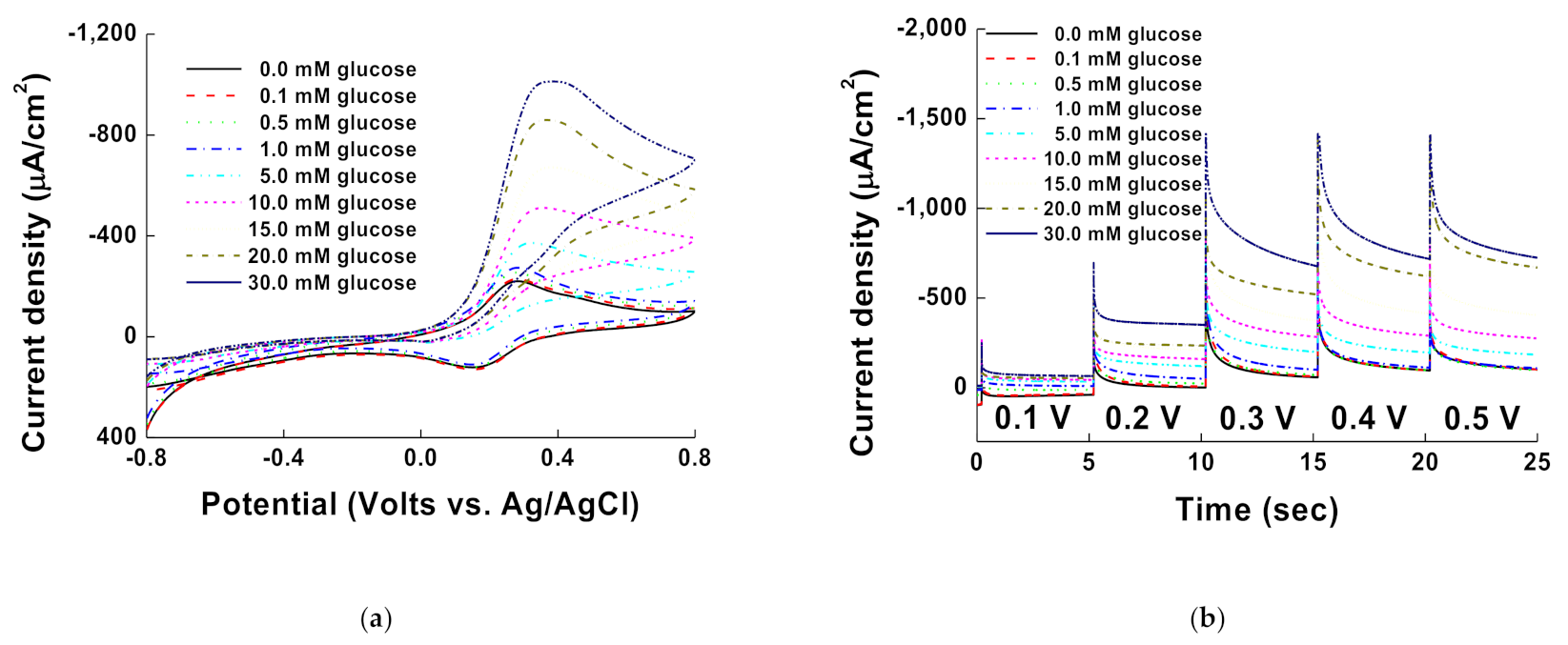
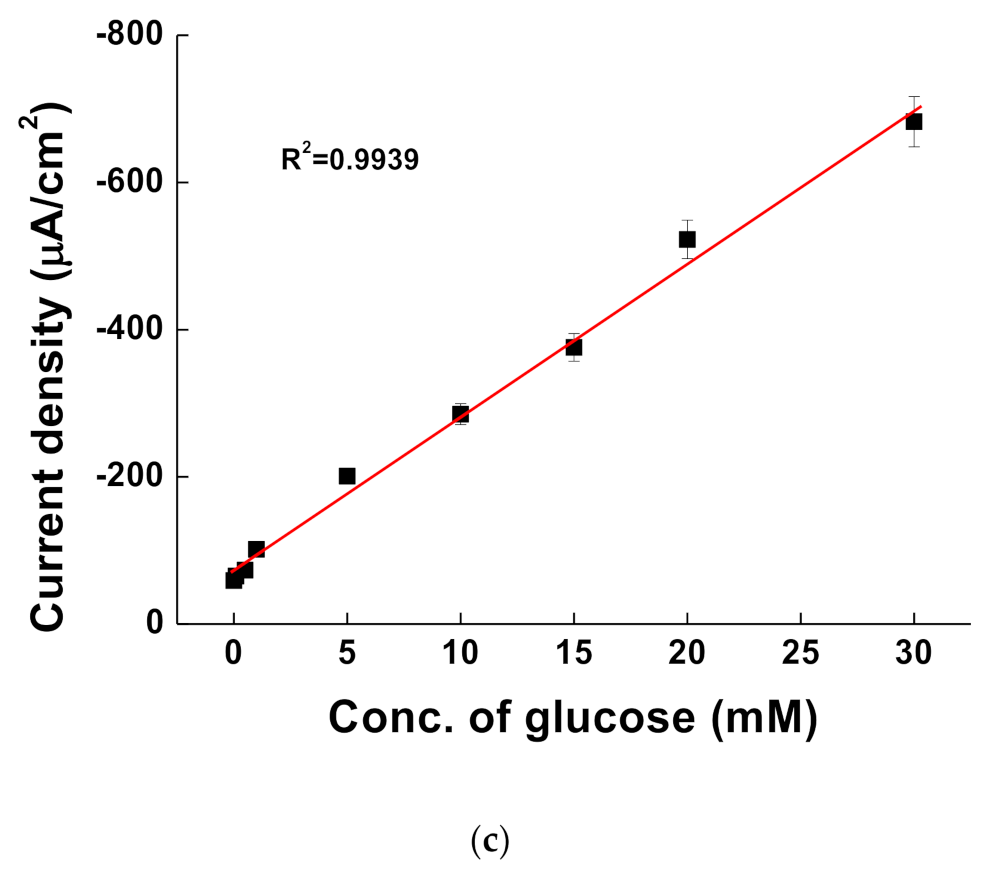
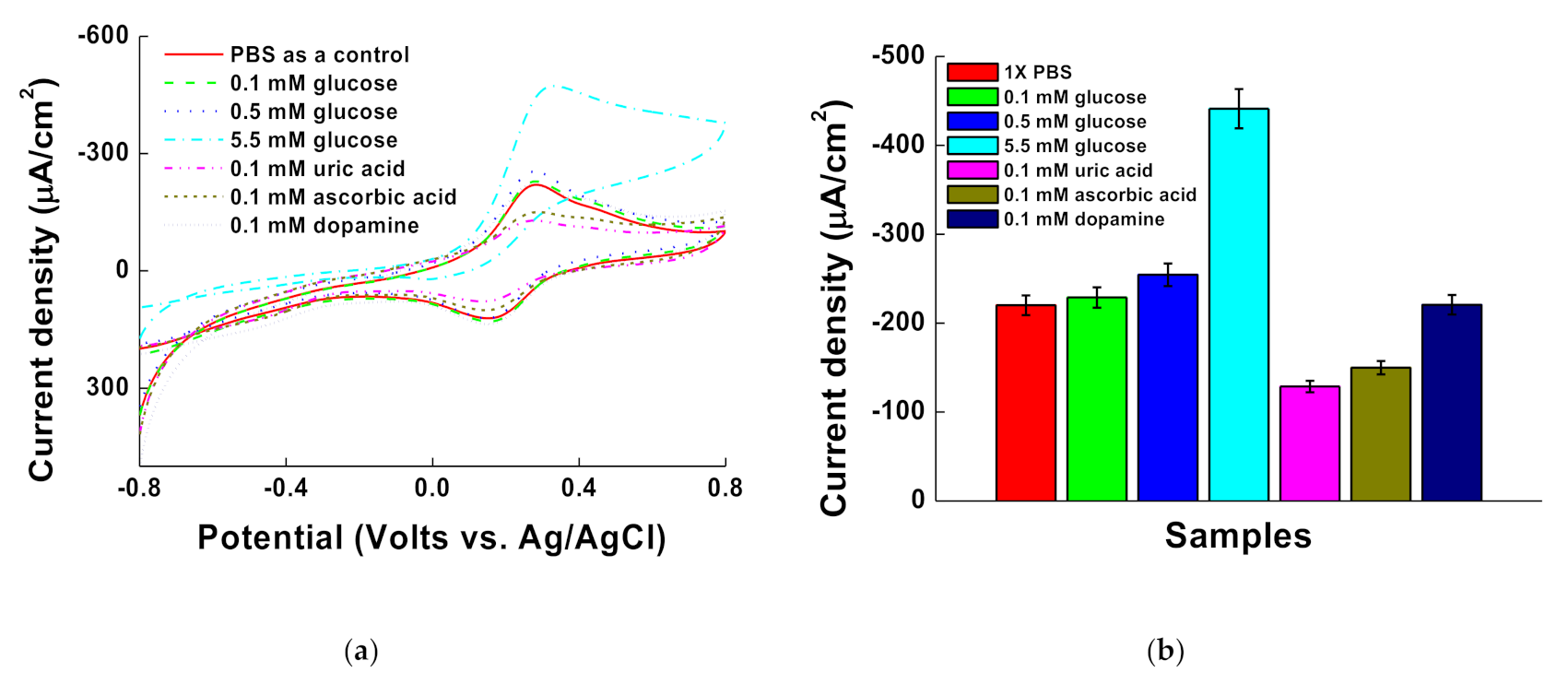
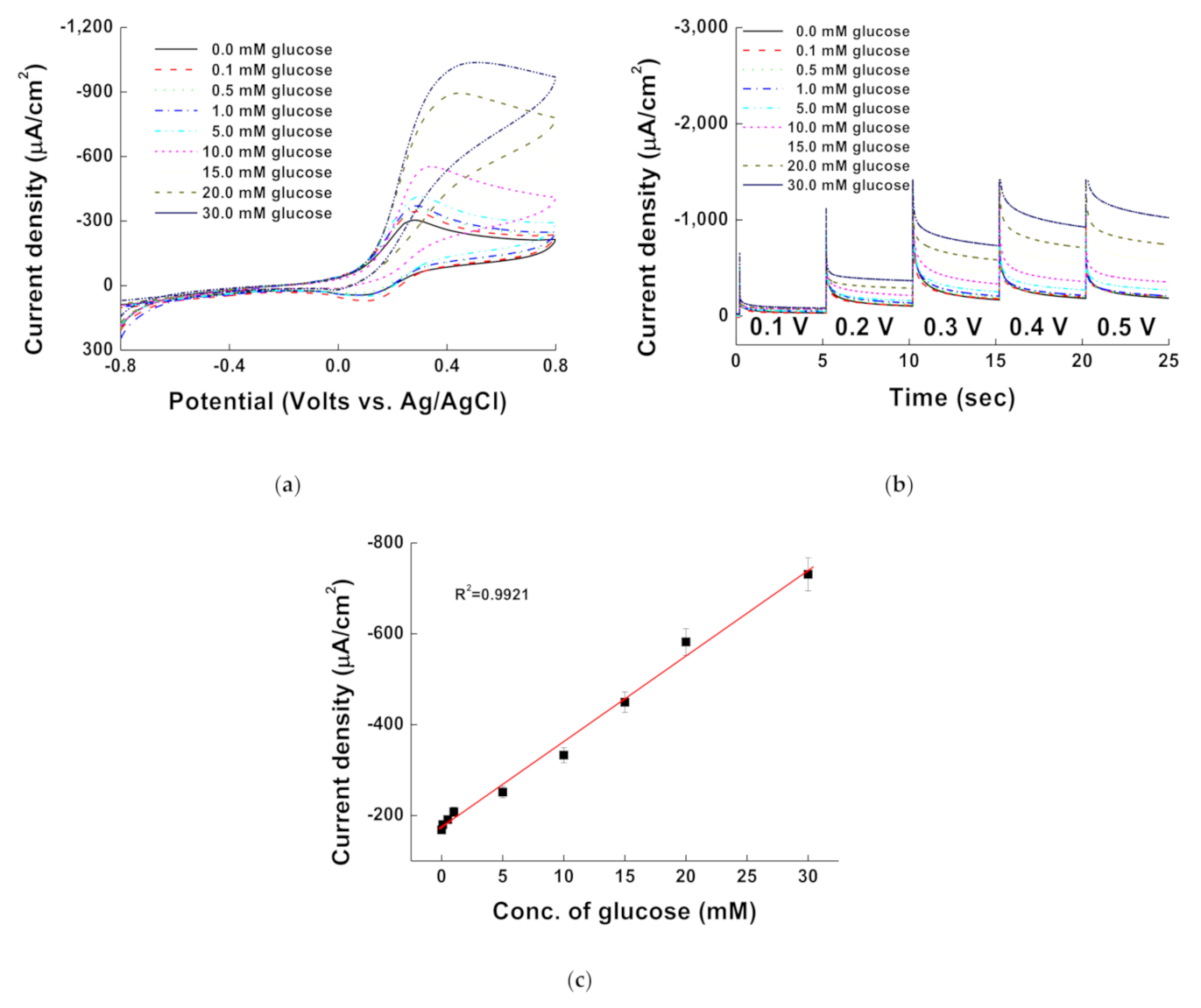
| Composite (Ratio of Amount) | TGA | HR-TEM | ||
|---|---|---|---|---|
| Mass Percentage of PDA (%) | Mass Percentage of MWCNT (%) | Ratio (PDA/MWCNT) | Average of PDA Thickness (nm) | |
| PDA–MWCNT (4:1) | 72.9 | 19.1 | 3.81:1 | 4.38 ± 0.22 |
| PDA–MWCNT (5:1) | 82.2 | 16.1 | 5.10:1 | 4.87 ± 0.29 |
| PDA–MWCNT (6:1) | 82.1 | 14.6 | 5.62:1 | 6.28 ± 0.51 |
| PDA–MWCNT (7:1) | 86.0 | 12.3 | 6.99:1 | 8.86 ± 0.48 |
| PDA–MWCNT (8:1) | 85.5 | 11.2 | 7.63:1 | 11.68 ± 0.83 |
| PDA–MWCNT (9:1) | 83.6 | 9.6 | 8.71:1 | 19.9 ± 1.02 |
| Assay | Sample | Nominal Concentration (mM) | Calculated Concentration (mM) | RSD (%) | Accuracy (%) | LOD (mM) |
|---|---|---|---|---|---|---|
| Intra | PBS | 0.1 | 0.101 | 3.47 | 101.28 ± 3.468 | 0.094 |
| 5.0 | 5.099 | 4.67 | 101.99 ± 4.667 | |||
| 15.0 | 15.801 | 3.56 | 105.34 ± 3.559 | |||
| 30.0 | 29.574 | 1.02 | 98.58 ± 1.018 | |||
| Spiking in Serum | 0.1 | 0.102 | 4.92 | 102.16 ± 4.920 | 0.584 | |
| 5.0 | 5.061 | 0.89 | 101.22 ± 0.887 | |||
| 15.0 | 14.73 | 1.57 | 98.22 ± 1.569 | |||
| 30.0 | 29.63 | 1.15 | 98.77 ± 1.147 |
| Electrode Type | Solution Type | Measurement Technique | Applied Potential(V) | Linear Range(mM) | LOD (mM) | Ref. |
|---|---|---|---|---|---|---|
| GOx/Pt–MWCNTSPCE | 0.1 M PBS, pH 7.5 | Chronoamperometry | −0.5 | 0.365–1.446 | 0.08326 | [39] |
| GOx–SWNT–PVI–Os/SPE | PB, pH 7.4 | Chronoamperometry | 0.3 | 0.2–7.5 | 0.1 | [40] |
| GOx/Pt/rGO/P3ABA/SPCE | PBS, pH 7.4 | Chronoamperometry | 0.5 | 0.25–6.0 | 0.0443 | [41] |
| Ru(dmo–bpy)2Cl2/GDH/PDA-MWCNT/SPCEs | PBS, pH 7.0 | MPS | 0.3 | 0.1–30.0 | 0.094 | Our work Our work |
| Serum | MPS | 0.3 | 0.1–30.0 | 0.584 |
Publisher’s Note: MDPI stays neutral with regard to jurisdictional claims in published maps and institutional affiliations. |
© 2021 by the authors. Licensee MDPI, Basel, Switzerland. This article is an open access article distributed under the terms and conditions of the Creative Commons Attribution (CC BY) license (https://creativecommons.org/licenses/by/4.0/).
Share and Cite
Jeon, W.-Y.; Kim, H.-H.; Choi, Y.-B. Development of a Glucose Sensor Based on Glucose Dehydrogenase Using Polydopamine-Functionalized Nanotubes. Membranes 2021, 11, 384. https://doi.org/10.3390/membranes11060384
Jeon W-Y, Kim H-H, Choi Y-B. Development of a Glucose Sensor Based on Glucose Dehydrogenase Using Polydopamine-Functionalized Nanotubes. Membranes. 2021; 11(6):384. https://doi.org/10.3390/membranes11060384
Chicago/Turabian StyleJeon, Won-Yong, Hyug-Han Kim, and Young-Bong Choi. 2021. "Development of a Glucose Sensor Based on Glucose Dehydrogenase Using Polydopamine-Functionalized Nanotubes" Membranes 11, no. 6: 384. https://doi.org/10.3390/membranes11060384
APA StyleJeon, W.-Y., Kim, H.-H., & Choi, Y.-B. (2021). Development of a Glucose Sensor Based on Glucose Dehydrogenase Using Polydopamine-Functionalized Nanotubes. Membranes, 11(6), 384. https://doi.org/10.3390/membranes11060384







